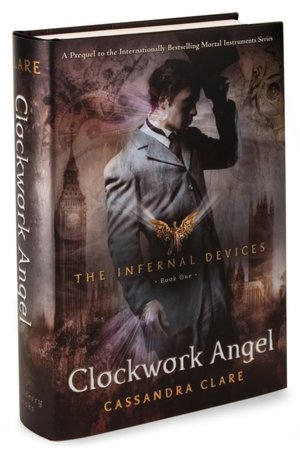Clare, Cassandra. Clockwork Angel: The Infernal Devices. New York: McElderry, 2010.
Audience: High School, 14+
Genre: Fantasy, Steampunk Fiction, Horror, Mystery, Romance
Topics of Focus: Supernatural World, Victorian Era, Coming of Age, Betrayal, Different Abilities, Power & Control, Industrial Revolution, Strong Female Protagonist
Red Flags: Gore
While fantasy, steampunk fiction is not usually my area of interest, I found Cassandra Clare’s Clockwork Angel: The Infernal Devices a fun and compelling read. Well-known for her Mortal Instruments series, Clare takes the reader in a different direction, back to the possibilities of the Victorian Age.
Set in 1878 London, the dark, grimy setting creates an authentic backdrop for the evil factions grappling for power and control in a new industrial world. This world consists of Mundanes, the normal humans; the Nephilim, a breed of half-human angels; Downworlders, the vampires, demons, warlocks, faeries, and other-worldly entities; the Shadowhunters, a faction of Nephilim who seek out and destroy the evil Downworlders; and the Automatons, humanesque robots that do the heinous bidding of the Downworlders.
Set in 1878 London, the dark, grimy setting creates an authentic backdrop for the evil factions grappling for power and control in a new industrial world. This world consists of Mundanes, the normal humans; the Nephilim, a breed of half-human angels; Downworlders, the vampires, demons, warlocks, faeries, and other-worldly entities; the Shadowhunters, a faction of Nephilim who seek out and destroy the evil Downworlders; and the Automatons, humanesque robots that do the heinous bidding of the Downworlders.
Clare’s main character, seventeen-year-old Tessa Gray, comes to London from New York City in search of her missing brother Nathaniel. Soon she is imprisoned by the Dark Sisters to undergo training and development of her unique ability, to shapeshift and think like her host shell. While shapeshifters are rather common in this dark world, Tessa’s ability to reach all the secrets and emotions of her shadow persona’s mind is rare and highly desired as a tool for control. Rescued by a small band of Shadowhunters, Tessa finds refuge in The Institute, a training facility and safe headquarters for the Niphilim. She is cared for and befriended by Charlotte and Henry Branwell, who head the Institute, and three other orphaned teens, Jessamine Lovelace, William Herondale, and Jem Carstairs. Will and Jem both become love interests for Tessa. Will, the recalcitrant emo boy with many secrets, sparks Tessa’s sexual desires. Jem, the drug-addicted, faithful soldier, encourages her empathy and affectionate trust.
As Tessa searches for clues to her brother’s whereabouts, she further harnesses her powers with the aid of the Shadowhunter group. As Tessa’s control of her shifting increases, Clare’s cast of characters grows with small adventures filled with violence, peril, quite a bit of gore, and hand-to-hand battle with the Downworlders. The novel is not just a full-throttle adventure tale. It includes the usual teen learning to find herself/himself, her budding sexuality and desire, trust issues, and the standard existential angst. Clare mixes all of these elements together in a complex, compelling, and ultimately fabulous story. There are no tidy little endings. Yes, the good guys are in the lead at the end, but there is much more room for the temporary calm to be further disrupted and the struggles savored. Readers will be impatient for more.
This will be a text that easily will fly off the library shelves and be passed from student to student. The vocabulary and sentence structure will be challenging for a younger audience. The gore will appeal to all. The broad cast of characters will require the reader to concentrate on the intricate structure. And maybe, the short snippets of Victorian poetry will lead a reader further down that reading path, as well. As Tessa says, “One must always be careful of books and what is inside them, for words have the power to change us” (87). Teachers and librarians can only hope.
Annotation by Denise Aulik

No comments:
Post a Comment